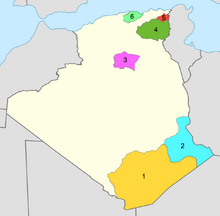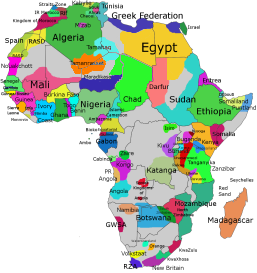|
| |||
| Capital (and largest city) |
Tamanrasset | ||
| Language official |
Tamahaq(various dialects) | ||
| others | Greek, French, English | ||
| Religion | Islam | ||
| Area | x km² (nominally ruled), y km² (ruled) km² | ||
| Population | est. x (y if all claimed territory is estimated) | ||
| Established | 1984 | ||
History
Pre-Doomsday
For most of history the area of modern Tamanrasset was just desert and mountains home too numerous nomadic peoples such as the Tuareg and the Songhai to call it home. During the colonial age the town of Tamanrasset was used as a military fort for the French military. Since then however the Tamanrasset area has become a town
Doomsday
The Southeast portion of Algeria was completely unaffected by the immediate effects of Doomsday and the fallout that occured afterwards. Within months however the Algerian government lost central control of the country, leaving the people of Ahaggar Mountains area to fend for themselves. Well the inhabitantants of the region, mostly Tuareg people, both nomadic and setttled, were glad to be free from control of the Arabized Alegerian Government, disunity amongst the various local tribes made the establishment of a nation state difficult.
Tribal Conflicts amongst Kel Ahaggar
Prior to 1977 The Kel Ahaggar, named after the Mountain region in the Tamanrasset Province, was the area's Tuareg population Confederation but in 1977 it was desolved by the Algerian Government. With Algerian army being more coastal rebellious areas, the Kel Ahaggar Confederation was reastablished and became the leading power in the region. However, the Dag Rali tribe opposed letting the Kel Rota, the traditional leader of the Confederation, from regaining power. The Dag Rali gained support from several other tribes and created a seperate state headed in the town of Abalessa. This lead to a number of clashs between the two groups that threatened to completely spilt the new-founded country apart. However during the summer of 1984 the nuclear summer lead to serious draughts and both sides came to gather and arange and agreement. The Kel rota would share power with the rest of the tribes and in return the capital would move back to Tamanrasset, which would also be the name of the new country.
The First Years
Within a year after Doomsday the Tuareg people of southern Algeria had united to form their own nation's. This was a historic event considering the fact that the Tuareg people had been tradtitonally nomadic and had feriously resisted the effects of nationalisiation in the countries of their residence. However, their were so serious issues the people of Tamanrasset had to face. During the mid and late 1980's the effects of Doomsday caused one of the worst draughts in history even causing hardships for the people of Kel Ahaggar. The Famine during these years is fought to have killed almost a quarter of the population. In order to stave off starvation the Tamanrasset government began to fiance raids into their neighbor nation Tamahaq, creating bad blood between the two that still exists. These issues several hampered the curiousity of Tamanrasset about the rest of the world and survival became to only goal.
Meeting with Kabylie
In the winter of 1985 a group of strange men were seen approaching the somewhat ill-defined borders of Tamanrasset, a military response was set to meet them because they were believed to be Alegrian's in an attempt to reclaim their territory.
Tamanrasset was founded in 1984 in the remains of southern Algeria. By 1997 it had expanded across the border into northern Niger. In 2002 it expanded across the former border into a unclaimed section of Mali.
Although formally a desert town with on average 70mm or 2.5 inches of rain per year this has increased by nearly two fold since 2000 to nearly 140mm or 5 inches of rain per year, mostly between January and May or the wet season. This however has not changed the ecology of the area vastly.
| ||||||||||||||||||||||



